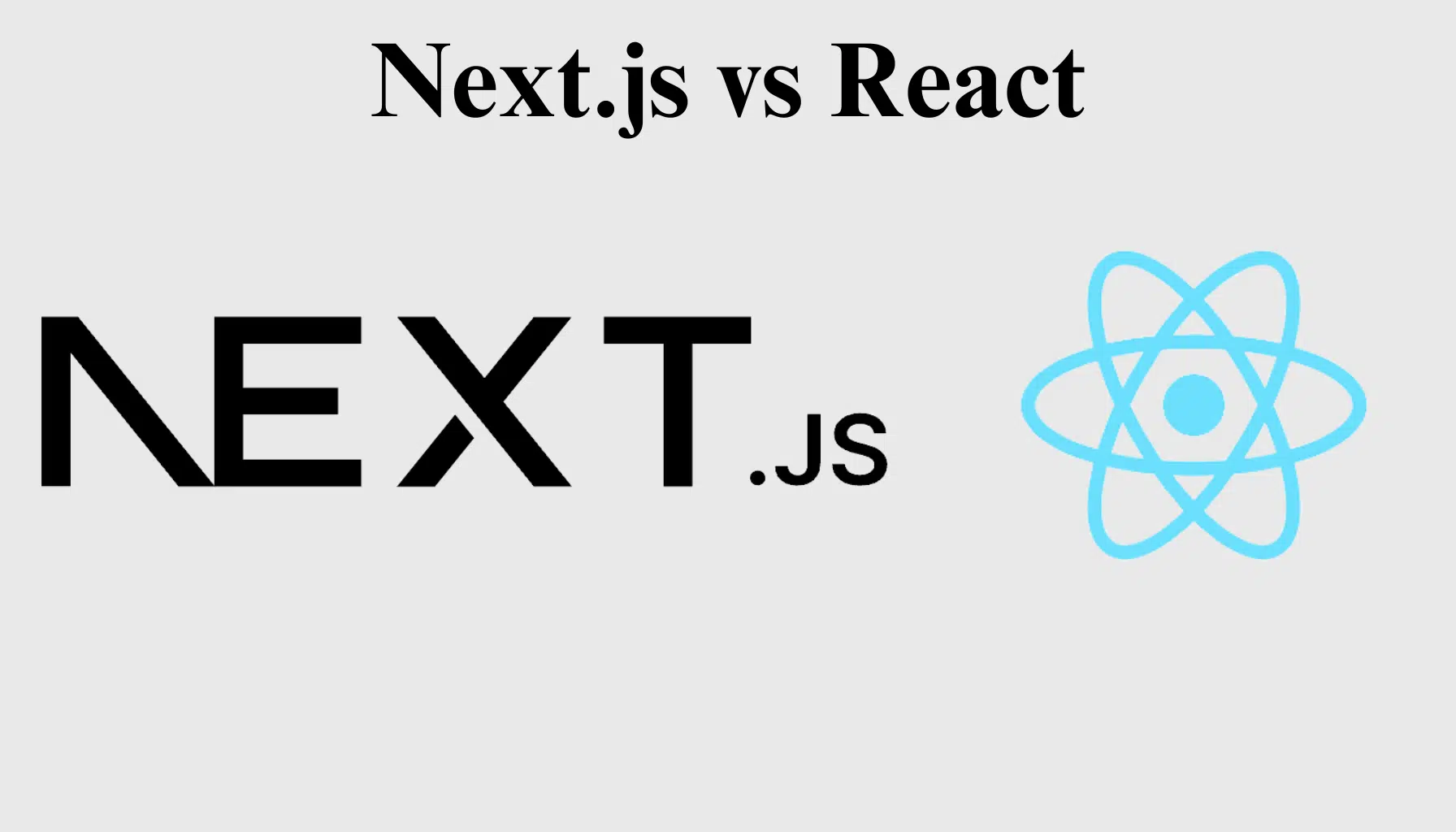Next JS vs React
The world of modern web development is continuously evolving, with Next.js and React emerging as two of the most dominant technologies for building web applications. React, a JavaScript library developed by Facebook (now Meta), is widely used for creating dynamic and interactive user interfaces, particularly for single-page applications (SPAs). On the other hand, Next.js, a React-based framework, enhances React’s capabilities by introducing features like server-side rendering (SSR), static site generation (SSG), and API routes, making it an excellent choice for performance-oriented applications.
As businesses and developers look for the best technology to build scalable and high-performing web applications, the debate between Next.js vs React continues to be a hot topic. While React offers greater flexibility and control, Next.js simplifies development by offering built-in tools for better performance, and scalability.
In this comprehensive comparison, we’ll break down the key differences, performance benchmarks, developer experience, scalability, hosting considerations, and future trends of both technologies. Whether you’re a startup looking for the most cost-effective solution or an enterprise scaling your application, this guide will help you choose the right technology for your needs in 2025.
Let’s dive into the Next.js vs React showdown to determine which one is the best fit for your next project!
What is Next.js?
Next.js is a React framework developed by Vercel that enhances React’s capabilities by introducing server-side rendering (SSR), static site generation (SSG), and hybrid rendering approaches. It provides an optimized development environment where developers can build high-performance applications with faster load times and improved scalability.
Key Features of Next.js:
- Server-Side Rendering (SSR) – Pages are rendered on the server for faster content delivery.
- Static Site Generation (SSG) – Generates pages at build time, reducing server load and improving speed.
- Incremental Static Regeneration (ISR) – Allows updating static content without rebuilding the entire site.
- API Routes – Backend functionality can be handled within the same project without an external backend.
- Built-in Image Optimization – Next.js optimizes images on the fly for better performance.
Next.js is widely used for content-heavy websites, blogs, eCommerce platforms, and enterprise applications that demand both speed and scalability.
What is React?
React is a JavaScript library created by Facebook (Meta) for building user interfaces (UI), particularly for single-page applications (SPAs). Unlike Next.js, React itself is not a full-fledged framework but provides a component-based architecture that allows developers to create interactive and reusable UI elements efficiently.
Key Features of React:
- Component-Based Architecture – UI is built using reusable components, making development modular.
- Virtual DOM – Improves rendering performance by updating only necessary UI elements.
- Client-Side Rendering (CSR) – Loads JavaScript bundles on the client-side, ensuring smooth interactivity.
- Hooks & Context API – Built-in features for state management and side effects in functional components.
- Rich Ecosystem – Supports multiple libraries and tools, allowing extensive customization.
React is best suited for dynamic applications, such as dashboards, social media platforms, real-time applications, and interactive user interfaces.
Next JS vs React: Key Differences at a Glance
The table below highlights the main differences between Next.js and React, helping you quickly identify which one fits your project needs.
Feature | Next.js | React |
Type | React Framework | JavaScript Library |
Rendering | Supports SSR, SSG, ISR, and CSR | Primarily CSR (requires extra setup for SSR) |
SEO Performance | High (pre-rendered pages) | Moderate (CSR affects indexing) |
Routing | Built-in file-based routing | Requires React Router |
Data Fetching | Supports API routes, SSR, and SSG | Uses third-party libraries (Fetch, Axios) |
Performance | Faster due to pre-rendering and caching | Depends on CSR and optimizations |
Hosting Options | Optimized for Vercel, Netlify, AWS | Works on any static hosting provider |
Best For | Blogs, eCommerce, Enterprise apps | SPAs, Dashboards, Interactive UIs |
Performance Comparison: Next JS vs React
Performance is a crucial factor when selecting a framework for web development. The speed at which a website loads and responds directly impacts user experience, and conversion rates. Let’s analyze how Next.js and React compare in terms of rendering, speed, and optimizations.
Server-Side Rendering (SSR) vs Client-Side Rendering (CSR)
Rendering strategy is one of the biggest differences between Next.js and React, and it significantly affects performance and results.
Client-Side Rendering (CSR) – How React Works
React primarily relies on Client-Side Rendering (CSR), where the browser downloads a JavaScript bundle, executes it, and renders the UI dynamically. While this method ensures faster interactions once the page is loaded, it delays the first contentful paint (FCP), affecting SEO and perceived performance.
CSR Downsides:
- Slower initial page load, as the user has to wait for the JavaScript to execute.
- SEO issues, as search engines struggle to index JavaScript-heavy content.
Server-Side Rendering (SSR) – How Next.js Improves Performance
Next.js introduces Server-Side Rendering (SSR), where pages are rendered on the server before being sent to the browser. This means users see content instantly, and search engines can index pages more effectively.
SSR Benefits:
- Faster first meaningful paint (FMP).
- Improves performance on low-powered devices since rendering happens server-side.
Static Site Generation (SSG) – Best of Both Worlds
Next.js also supports Static Site Generation (SSG), where pages are pre-built at deploy time, making them blazing fast. This method is ideal for blogs, documentation, and landing pages that don’t require frequent updates.
Final Verdict:
For applications that prioritize performance and better results, Next.js is the winner due to its SSR and SSG capabilities, while React (CSR) is better suited for highly interactive single-page applications (SPAs).
Speed and Load Time: Next.js vs React Benchmarks
Speed is a critical factor in web development, affecting SEO rankings and user retention. Let’s compare the real-world performance metrics of Next.js vs React.
Benchmark Data: Next.js vs React
- First Contentful Paint (FCP)
- Next.js (SSR & SSG): ~1.3s
- React (CSR): ~2.9s
- Largest Contentful Paint (LCP)
- Next.js: ~1.8s
- React: ~3.5s
- Time to Interactive (TTI)
- Next.js: ~2.2s
- React: ~4.1s
Real-World Examples of Load Time Differences
- E-commerce sites: Next.js pre-renders product pages, ensuring a faster browsing experience, while React (CSR) requires JavaScript execution before displaying content.
- Blogs & News websites: Next.js’s SSG mode delivers pre-built pages, reducing TTFB (Time to First Byte) compared to CSR-based React blogs.
Final Verdict:
Next.js delivers faster initial page loads and better user experience compared to React’s client-side rendering.
Caching and Image Optimization
Caching and image optimization are essential for boosting website speed, especially for content-heavy websites.
Next.js Automatic Caching
- Next.js caches static assets and pre-renders pages, reducing server load and response times.
- Implements Incremental Static Regeneration (ISR), allowing cached pages to be updated without a full rebuild.
React Caching Limitations
- React doesn’t have built-in caching mechanisms and requires additional service workers or third-party libraries for optimization.
Next.js Image Optimization API: A Game-Changer
One of the standout features of Next.js is its built-in Image Optimization API, which:
✔ Automatically compresses images to reduce file size.
✔ Delivers images in modern formats (e.g., WebP) for faster loading.
✔ Lazy-loads images to improve page speed.
React’s Approach to Image Optimization
React lacks native image optimization, so developers need to use external libraries like Cloudinary or imgix, adding complexity to the setup
Final Verdict:
Next.js’s built-in caching and image optimization significantly outperform React, making it the preferred choice for performance-focused applications.
Conclusion: Which One Wins in Performance?
Performance Factor | Next.js 🏆 | React ❌ |
Initial Page Load Speed | Faster (SSR/SSG) ✅ | Slower (CSR) ❌ |
SEO Optimization | High ✅ | Moderate ❌ |
Image Optimization | Built-in API ✅ | Requires external libraries ❌ |
Caching Mechanism | Built-in ISR ✅ | No default caching ❌ |
Next.js is the clear winner in terms of performance, speed, and optimization. If your project demands fast load times, SEO-friendliness, and scalability, Next.js is the way to go. However, if you prioritize highly interactive UI with more client-side logic, React remains a solid option.
Developer Experience: Which One is Easier to Work With?
When choosing between Next.js and React, developer experience plays a crucial role. Factors like ease of setup, learning curve, flexibility, and development speed determine how quickly a developer can build, scale, and maintain applications.
Setup & Learning Curve
Which Framework is Easier for Beginners?
For beginners, React is relatively easy to start with because:
✔ It’s just a JavaScript library, requiring only basic knowledge of JSX and components.
✔ The setup is simple using create-react-app or Vite.
✔ It has an abundant ecosystem with extensive community support.
However, as the project grows, developers need to manage routing, state, and API calls manually, making it more complex.
How Next.js Abstracts React’s Complex Configurations
Next.js simplifies React development by:
✔ Providing built-in routing (no need for React Router).
✔ Offering API routes (no need for a separate backend).
✔ Handling SSR, SSG, and ISR automatically.
✔ Optimizing performance with built-in image optimization and preloading.
Final Verdict:
If you’re building a simple project, React is easier to learn. But for large-scale applications with performance needs, Next.js abstracts much of the complexity, making development smoother.
Flexibility & Customization
React: More Flexible but Requires Third-Party Libraries
React is highly flexible and customizable, but that comes with a trade-off:
✔ You can use any state management library (Redux, Recoil, Zustand).
✔ You can implement custom routing solutions with React Router.
✔ Choose from multiple rendering strategies (CSR, SSR with external tools).
❌ However, you have to set up most features manually, increasing development overhead.
Next.js: Built-in Features for Faster Development
Next.js, being a framework, comes with built-in solutions:
✔ File-based Routing: No need for React Router.
✔ API Routes: Handle backend requests without setting up Express.js.
✔ Hybrid Rendering: Use SSR, SSG, ISR, or CSR where needed.
✔ Automatic Image Optimization: Improves performance without third-party tools.
Final Verdict:
React offers more flexibility, but Next.js provides more built-in solutions, reducing the need for extra configurations.
Development Speed & Productivity
Which One Accelerates Development?
Next.js speeds up development because:
- No need to install routing or API handling libraries.
- Server-side logic is built-in, making full-stack development seamless.
React is better for highly interactive applications because:
- It provides maximum freedom in how you structure and scale the app.
- A massive ecosystem of third-party tools allows fine-tuned customization.
Final Verdict:
For fast project setup and structured development, Next.js is the better choice. However, for highly interactive, real-time applications requiring deep customization, React gives developers more control.
Features & Use Cases: Which One is Best for Your Project?
Choosing between Next.js and React depends on your project requirements, scalability needs, and business goals. While both technologies are built on React, they serve different use cases based on performance, rendering needs, and flexibility.
When to Choose Next.js?
Next.js is the go-to framework for businesses looking for SEO-friendly, high-performance applications with built-in optimizations. It is ideal for projects that require server-side rendering (SSR), static site generation (SSG), or hybrid rendering.
Best Use Cases for Next.js
✔ SEO-Driven Websites – Next.js ensures faster page loads and better search engine rankings by pre-rendering pages.
✔ eCommerce Platforms – Dynamic product pages benefit from Incremental Static Regeneration (ISR), ensuring fast, updated content.
✔ Blogs & News Websites – Static Site Generation (SSG) makes content-heavy sites load instantly.
✔ Enterprise-Scale Web Apps – Next.js simplifies full-stack development with built-in API routes and SSR.
✔ B2B SaaS Applications – Offers secure, scalable, and fast-loading dashboards for enterprise clients.
✔ Landing Pages & Marketing Sites – Ensures high Core Web Vitals scores, improving ad conversions and lead generation.
Example Projects Perfect for Next.js
When to Choose React?
React is perfect for highly interactive web applications, dashboards, and single-page applications (SPAs) where user experience and dynamic updates are the top priorities.
Best Use Cases for React
✔ Single-Page Applications (SPAs) – React excels in dynamic, highly interactive applications where real-time updates matter.
✔ Custom UI/UX Applications – Ideal for projects requiring complex animations, dynamic content, and deep user interactions.
✔ Social Media Platforms & Chat Applications – Works well for real-time apps like messaging, commenting, and live updates.
✔ Data-Heavy Dashboards – Handles real-time data visualization and state management with libraries like Redux and Recoil.
✔ Mobile Apps (React Native) – React components can be reused in React Native mobile applications, reducing development effort.
✔ Gaming & Entertainment Applications – Useful for web-based games, media streaming, and interactive experiences.
Example Projects Perfect for React
Real-World Companies Using Next.js vs React
Many tech giants use Next.js and React based on their specific needs. Below are some well-known companies using each technology:
Companies Using Next.js
✔ Netflix – Uses Next.js for server-side rendering to improve performance.
✔ Twitch – Leverages Next.js for faster content delivery and better caching.
✔ TikTok – Uses Next.js for user-generated content indexing.
✔ Nike – Uses Next.js for its high-performance and scalable eCommerce platform.
✔ Uber – Utilizes Next.js for optimizing page speed.
Companies Using React
✔ Facebook – Developed React and uses it extensively in its UI components.
✔ Airbnb – Uses React for rich, interactive web applications.
✔ WhatsApp Web – Uses React for its real-time messaging interface.
✔ Discord – React powers its complex UI for real-time chat and interactions.
✔ Instagram – Uses React for dynamic content and user interactions.
Final Verdict:
Next.js excels in performance-driven applications like eCommerce, corporate sites, and news portals.
React remains the best choice for highly interactive, real-time applications like social media, chat apps, and dynamic dashboards.
Conclusion: Choose based on your project goals!
Scalability & Maintainability: Which One is Better for Long-Term Growth?
Scalability and maintainability are key considerations when building a long-term, high-traffic application. A framework should handle increasing user demand, content updates, and complex workflows without performance degradation. Let’s compare how Next.js and React perform in terms of scalability, maintainability, and state management.
How Easy is it to Scale Next JS vs React?
Which Framework is Better for Large Projects?
For large-scale applications, the ease of scalability depends on:
✔ Handling high traffic efficiently
✔ Managing large codebases
✔ Supporting multi-team collaboration
✔ Long-term framework viability
Next.js Scalability:
- Server-Side Rendering (SSR) reduces the client-side processing load, making it easier to scale.
- Incremental Static Regeneration (ISR) enables on-demand updates to static content, reducing the need for full rebuilds.
- Built-in API Routes simplify backend logic without needing an external server.
- Optimized for cloud platforms like Vercel, AWS, and Netlify, making scaling infrastructure seamless.
React Scalability:
- Requires external tools like Redux, React Query, and custom SSR implementations for performance tuning.
- Large applications may face state management complexities, needing code-splitting and lazy loading for optimization.
- Works well for highly interactive SPAs but struggles with server-side optimizations and SEO-heavy applications.
Code Maintainability & Long-Term Viability
✔ Next.js is highly maintainable due to its structured approach with built-in routing, API handling, and rendering strategies.
✔ React requires additional configurations to maintain large projects, as developers must manage routing, state, and API calls manually.
Final Verdict:
For large-scale enterprise applications and growing businesses, Next.js offers better scalability and maintainability. React remains viable for SPAs but requires extra effort to scale efficiently.
State Management & Data Fetching
State management and data fetching are crucial for modern web applications. While both Next.js and React offer solutions, their approaches differ significantly.
Next.js: API Routes, SWR, and getServerSideProps
✔ API Routes – Next.js allows defining backend API endpoints directly within the project, eliminating the need for a separate backend in many cases.
✔ SWR (Stale-While-Revalidate) – A React hook library designed for fast, efficient data fetching, caching, and automatic revalidation.
✔ getServerSideProps() – Fetches data at request time for server-side rendering (SSR), ensuring content is always up-to-date.
✔ getStaticProps() – Fetches data at build time for static site generation (SSG), enhancing performance.
Next.js Advantage: Provides a unified way to fetch and manage data, reducing the need for external libraries.
React: Redux, React Query, and Apollo GraphQL
✔ Redux – The most popular state management library, but requires additional setup and middleware.
✔ React Query – Handles server state, caching, and data synchronization, reducing API request overhead.
✔ Apollo GraphQL – Ideal for projects using GraphQL, but adds complexity in managing queries and caching.
✔ Fetch/Axios – Requires additional code for API calls and state management.
React Limitation: No built-in data fetching solutions; developers must rely on third-party libraries.
Final Verdict: Next.js vs React for Data Management
Feature | Next.js 🏆 | React ❌ |
Built-in API Routes | ✅ Yes | ❌ No |
Data Fetching Methods | ✅ getServerSideProps, SSG, ISR | ❌ External libraries needed |
Real-Time State Management | ✅ SWR, ISR | ✅ Redux, React Query, Apollo |
Ease of Use | ✅ Easier with built-in solutions | ❌ Requires setup and additional configurations |
Next.js offers a more structured, built-in solution for state management and data fetching, making development smoother. React is flexible but relies heavily on third-party tools.
Conclusion: Which One is Better for Scalability & Maintainability?
✔ For large, complex, and high-traffic projects → Choose Next.js.
✔ For real-time dashboards, highly interactive SPAs → Choose React.
✔ For projects needing seamless state management and API handling → Next.js is the winner.
Final Recommendation: If you’re looking for a long-term scalable solution with easy maintainability and built-in optimizations, Next.js is the clear choice.
Cost & Hosting Considerations: Next JS vs React
When choosing between Next.js and React, hosting and deployment costs play a crucial role in determining the overall feasibility of your project. While both technologies are free and open-source, the infrastructure, hosting, and long-term maintenance costs vary significantly.
Hosting Next JS vs React Applications
Hosting requirements for Next.js and React differ based on their rendering strategies. Let’s explore the best hosting options and their associated costs.
Best Hosting Options for Next.js
Next.js supports server-side rendering (SSR), static site generation (SSG), and API routes, requiring specialized hosting solutions optimized for performance.
✔ Vercel (Best for Next.js) – Free tier available, automatic deployments, built-in caching, and CDN support.
✔ Netlify – Great for static Next.js applications (SSG) with instant cache invalidation.
✔ AWS Amplify – Works well for large-scale Next.js applications with API and Lambda functions.
✔ DigitalOcean/App Platform – Cost-effective alternative with custom scalability options.
Best Hosting Options for React
React applications primarily use client-side rendering (CSR), making them compatible with any static file host.
✔ Firebase Hosting – Free tier available, integrates well with React and Firestore.
✔ GitHub Pages – Ideal for static React apps, but lacks SSR capabilities.
✔ Vercel & Netlify – Also work for React but mainly shine for Next.js applications.
✔ AWS S3 & CloudFront – Perfect for scalable, low-cost deployments of static React apps.
Deployment Ease & Costs
Next.js Deployment:
- Static deployments (SSG) are free on Vercel/Netlify, but SSR requires a backend, increasing hosting costs.
- Enterprise applications with heavy SSR need dedicated AWS or DigitalOcean servers, raising costs.
React Deployment:
- CSR React apps can be hosted for free or very low cost using Firebase, GitHub Pages, or Netlify.
- No backend needed unless integrating APIs, making hosting cheaper.
Final Verdict:
- For cost-effective static websites → React wins.
- For high-performance applications → Next.js is the best choice despite slightly higher hosting costs.
Cost of Development & Maintenance
The total cost of development and maintenance includes infrastructure, ongoing updates, and developer expertise.
Cost of Development & Maintenance
The total cost of development and maintenance includes infrastructure, ongoing updates, and developer expertise.
Next.js: Higher Initial Cost, Lower Long-Term Maintenance
- Initial development costs are higher due to SSR/SSG configurations and API route implementations.
- Long-term costs are lower as Next.js applications require fewer third-party optimizations, leading to better performance and reduced maintenance efforts.
React: Lower Initial Cost, Higher Maintenance
- Cheaper initial development since React is lightweight and flexible.
- Higher maintenance costs over time due to the need for third-party libraries (React Router, Redux, etc.) and manual optimizations.
- Best for startups and MVPs looking for fast development with lower upfront costs.
Final Verdict:
✔ For long-term savings and scalability → Next.js is more cost-effective.
✔ For quick, budget-friendly development → React is a better choice.
Final Thoughts: Next.js vs React in Cost & Hosting
Factor | Next.js 🏆 | React ❌ |
Best Hosting Option | Vercel, AWS, Netlify ✅ | Firebase, GitHub Pages, AWS S3 ✅ |
Hosting Cost | Higher for SSR ✅ | Lower for CSR ✅ |
Ease of Deployment | Requires specialized hosting ✅ | Works on any static hosting ✅ |
Development Cost | Higher upfront ✅ | Lower upfront ✅ |
Maintenance Cost | Lower in the long run ✅ | Higher due to third-party dependencies ❌ |
Future & Trends: Is Next.js Overtaking React?
As web development evolves, Next.js and React continue to introduce new features and optimizations. While React remains the foundation for both, Next.js is gaining traction due to its built-in performance enhancements and hybrid rendering capabilities. Let’s explore their current trends and future roadmaps to see how Next.js is shaping the future of web development.
Current Trends & Popularity in 2025
Recent Developments in Next.js & React
- Next.js 14+ introduced faster server components, middleware improvements, and edge rendering for ultra-low latency web apps.
- React 18+ focused on Concurrent Rendering, Suspense for Data Fetching, and Server Components, improving React’s flexibility in handling complex UI interactions.
- The rise of AI-powered applications and cloud-based computing has made Next.js more attractive due to its seamless integration with edge computing and server-side data processing.
Google Trends Comparison: Next.js vs React
A Google Trends analysis shows that:
📈 Next.js has seen a massive surge in popularity over the past three years, especially among enterprise and performance-focused applications.
📉 React remains dominant but has plateaued in growth, as developers seek more structured frameworks like Next.js for scalability.
Final Verdict:
While React remains the foundation for UI development, Next.js is becoming the preferred choice for modern web apps due to its built-in optimizations and full-stack capabilities.
Future Roadmap: What’s Next for Next.js & React?
Next.js: Evolution with AI & Edge Computing
Next.js is moving toward:
✔ AI-Powered Applications – Next.js will have better integrations with AI models (e.g., OpenAI, TensorFlow) for smart web applications.
✔ Edge Computing & Middleware – Next.js will enhance edge functions for real-time applications, enabling faster response times and lower latency.
✔ Improved Data Fetching & Caching – The introduction of automatic caching strategies will further optimize dynamic content delivery.
✔ More Seamless Full-Stack Capabilities – Next.js aims to replace traditional backend services by offering advanced API routes and database integrations.
React: Upcoming Server Components & Optimizations
React is evolving with:
✔ React Server Components (RSC) – Allowing components to be rendered on the server for better performance.
✔ Improved Hydration for SPAs – Making initial loads faster by optimizing client-side hydration.
✔ Integration with Streaming & AI-Powered UI – Enabling smarter, context-aware interfaces for next-gen web apps.
✔ Stronger Developer Tooling – Improving the React Developer Tools for easier debugging and state management.
Final Verdict: Who Will Dominate?
- Next.js is pushing toward a full-stack framework, making it ideal for modern web apps, AI, and high-performance needs.
- React is evolving but remains a UI-focused library, meaning Next.js will likely dominate for production-ready applications, while React continues to power front-end interfaces.
Conclusion:
- If you’re building scalable applications with advanced optimizations → Next.js is the future.
- If you need a lightweight, flexible UI library for SPAs or highly interactive apps → React remains the best choice.
Final Thought: Next.js is not replacing React—it’s enhancing it. However, with the rise of edge computing and AI-driven applications, Next.js is quickly becoming the go-to framework for modern web development.
Conclusion: Which One Should You Choose?
Both Next.js and React are powerful technologies, but choosing the right one depends on your project requirements, scalability needs, and long-term goals. While React offers flexibility and deep UI customization, Next.js enhances it with performance optimizations and full-stack capabilities for modern web applications.
Best Use Cases for Next.js
Choose Next.js if your project prioritizes:
✔ Performance & Optimization – Ideal for fast-loading, scalable applications like eCommerce, blogs, and landing pages.
✔ Hybrid Rendering – Supports a mix of SSG, SSR, and CSR for flexible content delivery.
✔ Scalability & Edge Computing – Optimized for cloud-native apps, AI-driven solutions, and real-time content delivery.
✔ Enterprise & B2B SaaS Applications – Provides a secure, high-performance, full-stack approach.
Best Use Cases for React
Choose React if your project focuses on:
✔ Highly Interactive UI & SPAs – Perfect for dashboards, real-time analytics, and social media applications.
✔ Full Control Over Architecture – Need a custom approach with different libraries for routing, state management, and data fetching.
✔ Cross-Platform Development – Planning to build both web and mobile apps using React Native.
✔ Low Hosting Costs & Faster Deployment – Simple static applications can be hosted cost-effectively on Firebase, AWS S3, or GitHub Pages.
Final Verdict: Which One is Right for Your Project?
- For scalability and fast performance → Next.js is the better choice.
- For a lightweight, flexible UI framework → React is ideal for interactive apps.
- For large-scale applications with high traffic and dynamic content → Next.js wins.
- For real-time dashboards or social apps → React is your best bet.
We Are the Best Next.js & React Development Company in the US
At Taction Software, we specialize in delivering high-performance, scalable, and secure web applications using Next.js and React. As a leading Next.js development company in the US and the best React development company in the US, we provide tailored solutions that empower businesses with modern, robust, and user-friendly applications.
Why Choose Us for Next.js & React Development?
✔ Expertise in Next.js & React – Our team of experienced developers builds fast, scalable, and maintainable applications that meet the highest industry standards.
✔ Custom Web & App Development – Whether you need a single-page application (SPA), a full-stack web solution, or a complex enterprise application, we design and develop solutions that align with your business goals.
✔ Performance-Driven Applications – We leverage Next.js’s server-side rendering (SSR) and static site generation (SSG) to create applications that load faster and provide seamless user experiences.
✔ End-to-End Development Services – From UI/UX design to front-end and back-end development, our team ensures a smooth development cycle with clean, maintainable code.
✔ Trusted by Leading Brands – As a top Next.js and React development company in the US, we have successfully built scalable and high-performing web applications for businesses across various industries, including healthcare, finance, eCommerce, and enterprise solutions.
🚀 Looking for the best Next.js or React development company in the US? Let’s build your next-generation web application with cutting-edge technology and future-ready solutions!
📞 Contact us today to discuss your project and see how we can help bring your vision to life with Next.js and React development expertise!
FAQs: Quick Answers to Common Questions
No, Next.js is not replacing React—it is built on top of React and enhances it with server-side rendering (SSR), static site generation (SSG), and API routes. While Next.js is gaining traction for performance and scalability, React remains the core library for UI development, powering SPAs, mobile apps (React Native), and interactive web applications.
No, Next.js requires React. It is a framework that extends React’s capabilities by adding server-side rendering (SSR), static site generation (SSG), and performance optimizations. However, if your project only requires client-side rendering (CSR) and a lightweight front-end solution, you can use React without Next.js.
Feature | Next.js 🏆 | React ⚡ |
Type | Framework built on React | JavaScript UI Library |
Rendering | SSR, SSG, ISR, CSR | CSR only (SSR needs extra setup) |
SEO Performance | High (Pre-rendered pages) ✅ | Moderate (CSR affects indexing) ❌ |
Routing | Built-in file-based routing ✅ | Requires React Router ❌ |
Data Fetching | getServerSideProps, getStaticProps ✅ | Fetch/Axios, React Query, GraphQL ❌ |
Performance | Faster due to SSR/SSG ✅ | Requires optimization ❌ |
Hosting | Optimized for Vercel, Netlify, AWS ✅ | Works on any static hosting ✅ |
Best For | SEO, eCommerce, Blogs, Enterprise Apps | Interactive SPAs, Dashboards, Social Media Apps |
No, Next.js is not harder to learn than React, but it has more built-in features that require understanding server-side rendering, API routes, and static generation.
- React is simpler for beginners as it focuses only on building UI components.
- Next.js requires learning additional concepts like SSR, SSG, and file-based routing.
- If you already know React, learning Next.js is straightforward.
👉Final Verdict: If you’re just starting with JavaScript frameworks, learn React first. If you’re comfortable with React and want to build faster, high-performance web applications, Next.js is worth learning.













